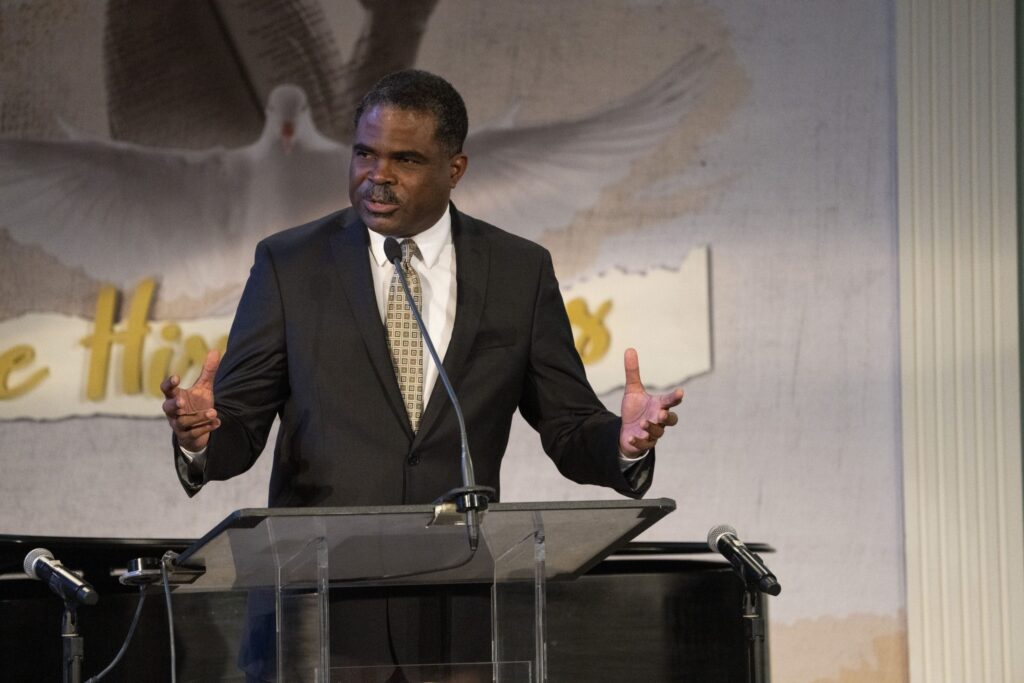Seventh-day Adventist leaders hope that a major shift in the use of funds will contribute to less spending on administrative positions and more on targeted frontline missionary activities around the world. It was a notion General Conference treasurer Paul H. Douglas emphasized several times during his report to members of the GC Executive Committee (GC-EXCOM) October 10, 2022. Douglas’ presentation, titled “Investing in Mission,” crowned the Treasury department’s financial report during the 2022 Annual Council in Silver Spring, Maryland, United States.
“There is an old adage that says, ‘Put your money where your mouth is,’” Douglas told the delegates. “I would like to translate that adage to us today by saying, ‘We need to put our money where the mission is.’”

General Conference Treasurer Paul H. Douglas. [Photo: Enno Müller, Adventist Review]
From Mission Strategy to Outcomes
Douglas defined three elements that inform the church’s mission strategy. He said they are Intelligence, Integration, and Investment.
“Intelligence is knowing where to go, where those who are still unreached are, and where are the opportunities so we can broadcast them and find the people who can fit these opportunities,” he said.
The church also needs integration, because everyone needs to be working together with just one cause, just one purpose, Douglas said. “We also need investment of our financial and human resources to be aligned intentionally to the mission strategy,” he said.
Douglas explained that the mission strategy we have should have an expected outcome. “We need to reflect whether we had or not the right intelligence. Do we have the right balance of integration? Do we have the right balance of investment to ensure that there is an effective outcome in our strategy?” he asked.
Highlighting Mission
Douglas then shared five elements that can inform this shift toward dedicating more funds to frontline mission.
First, he said, it is important to prepare financial reporting to highlight mission. The current financial reporting usually highlights appropriations, funding for international employees (missionaries), the GC Auditing Services (GCAS), GC Administered and office operations, Douglas explained.
“To the untrained eye, none of that tells you anything. It tells you who got what, but it doesn’t tell us what we did,” he said.
Douglas revealed that starting in January 2023, the new financial reporting will focus more on mission strategy and support, educational institutions, and media and publications. Besides regular office operations, it will also seek to zero in on leadership development and accountability. “We need financial reporting that focuses us on mission,” he said.
Increasing Self-Support
Another key element is to promote higher levels of self-support for organizations. Douglas explained that in the next few months, GC Treasury leaders will begin a study of appropriations, or the resources the GC distributes to the world field.
“We need to be more targeted, more strategic in our use of appropriations,” Douglas said, while explaining that there are some tough questions leaders need to ask themselves. “Are we supporting the administration of a division or are we supporting the mission activities in the territory?” he asked. “We will need to adjust how we look at appropriations and shift to support the strategic decisions related to the use of our resources.”
Douglas said leaders believe that promoting higher levels of self-support will enable a greater focus on mission, because entities will be able to live within their means, and the resources they receive can be focused on a particular area.
“Imagine if, instead of just receiving a part of the pie, we target together a particular area and invest in that area because we seek a certain outcome,” he said.
Mission, Not Machinery
The idea, Douglas said, is to learn ways of positioning resources toward mission and not machinery or administrative expenses. He referenced an informal survey taken of the delegates a day before that showed that most of them believed that most funds allocated to international employees (those who work in another division as missionaries) are spent on frontline mission.
The truth, Douglas said, is that most of the funds are spent on administration professionals—“in the machinery, not the mission.” In that regard, he added, “What you are thinking it is, what you perceive it to be, is not so. Yes, our investments should be in the frontline but in fact, they are in the machinery.”
Douglas explained that an analysis of the current use of budgets for mission shows that out of 31 possible points, the average score worldwide is 8.1, something that highlights the church’s mission drift and the need to refocus mission resources.
“We need to move from 8.1 points to 31,” he said.
If leaders want to increase the allocation of funds to mission, it is essential to change the criteria used. Among other things, Douglas reaffirmed the mission refocus criteria adopted by the Church for implementing direct contact mission with the goal of creating new worshiping groups. Leaders will also focus on 10/40 Window countries, people groups of non-Christian religions, and urban areas with populations above one million people. He also mentioned postmodern and post-Christian countries or regions; low Adventist-to-population ratios in countries, regions, or people groups; and high impact equipping for direct contact mission. “The key question we need to ask ourselves is, ‘How do we move our resources from the machinery to the mission?’” he said.


